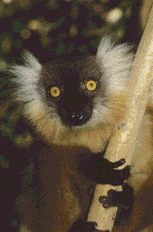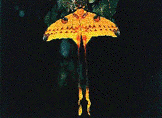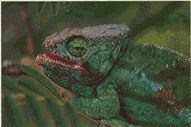 FAUNA FAUNA |
Like a giant Noah's ark breasting the ocean, Madagascar is packed with every imaginable creature. Madagascar's dwindling forests are home to an enormous variety of unique plant and animal life, including more than 6,000 species of flowering plant, half the world's chameleon varieties, 300 species of butterfly, 256 species of bird, 28 kinds of bat, 150 types of frog and 260 different reptiles, all sorts of mammals . Apart from the scorpions, Madagascar has no beast which are dangerous to humans.
Madagascar is a sanctuary for Lemurs. Introduced long ago by the island's first inhabitants, Lemurs are now only found on Madagascar and on the Comoro Islands. 30 species of lemur are currently recognized.

Lemurs range in size from the mouse lemurs (Microcebus, Phaner) which are about 60 g, to the gentle lemurs (Hapolemur) which are about the size of a large cat. Lemurs are completely arboreal except the ring-tailed lemur (Lemur catta), named maki by Malagasy, which spends much of its time on the ground where it travel on all fours and enjoys sunning itself. It is the most familiar because it manages well in captivity. It is easily recognizable with it black-and-white striped tails. Lemurs resemble advanced primates chiefly in the structure of their hands and feet. They feed primarily on insects, leaves, fruit, bird's eggs, birds and reptiles.
| 
Among the most familiar lemurs, we can mention the following species: Lemur fulvus (brown lemur), Hapalemur aureus (golden bamboo lemur), Hapalemur griseus (grey bamboo lemur), Microcebus murinus (grey mouse lemur), Microcebus rufus (rufous mouse lemur), Propithecus verreauxi (verreaux's sifaka), Propithecus diadema (diademed sifaka), Indri indri (indri) and Daubentonia madagascariensis (Aye-aye). Some lemurs are nocturnal, others are active at dusk and a few are diurnal.

Because of destruction of their habitat (deforestation) by humans, their number are steadily dwindling. So, some species are in danger and at extreme risk of extinction. |

